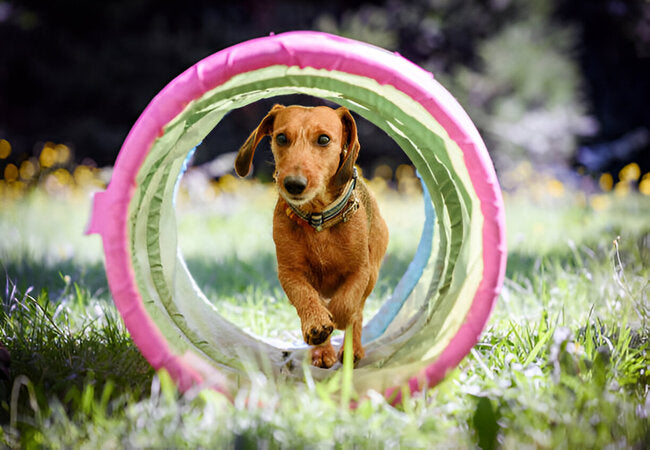Understanding Prey Drive in Dogs: Vet‑Approved 2025 Guide to Instinct & Control 🐶🎯

In this article
Understanding Prey Drive in Dogs: Vet‑Approved 2025 Guide 🐶🎯
By Dr. Duncan Houston BVSc
That moment when your dog suddenly freezes on a squirrel, leaps into chase, or relentlessly chases a toy—those are signs of prey drive. This instinct is rooted in your dog’s ancestry and remains strong even in our modern companions. In this 2025 guide, we’ll explore what prey drive is, signs across different breeds, where it overlaps with aggression, and how to channel it safely through training, enrichment, and management. Let’s dive in! 🐾
What Is Prey Drive?
Prey drive is an innate behavioral sequence dogs inherited from wolves: search → stalk → chase → catch → bite (grab/kill). In pet dogs, this often pauses after catching prey or retrieving a toy—it may not progress to the kill phase.
It’s normal and instinctive, not rooted in fear or power—though its outcomes can sometimes cause conflict if unmanaged.
Which Breeds Display Strong Prey Drive?
Certain breeds retain more of these instincts through selective breeding:
- Terriers: enhanced grab and kill stages, bred to hunt vermin.
- Hounds & Sighthounds: strong chase or search instincts—Beagles, Greyhounds, Whippets.
- Herding breeds: emphasis on stalking and chase (e.g. Border Collies).
- Sporting dogs: retrievers, pointers—chase and catch, but inhibited bite.
However, even lap dogs can react with strong prey drive—cats, moving toys, or bikes can trigger it.
Signs of Prey Drive in Daily Life
- Freeze or stare at small animals or fast movement.
- Slow stalk, crouched body, low head.
- Sudden bolt chase after squirrels, bikes, or children riding scooters.
- Intense toy-catching, tug-of-war, leap-and-grab games.
- Excitement and difficulty disengaging from moving targets.
Prey Drive vs. Aggression
Prey drive differs from aggression in that it’s goal-driven and neutral, not emotional. Predatory aggression—like real bites to kill—is uncommon in pet dogs and doesn’t carry emotional arousal like fear-based aggression.
Still, strong prey drive can look alarming—so context and your dog's body language matter deeply.
When Does Prey Drive Become a Problem?
Problems arise if:
- Your dog chases small animals off-leash or breaks fencing.
- Chasing causes risk—traffic danger, fights, or injury.
- They can’t disengage—obsessive tracking or pacing on leash.
- Conflict arises—chasing family pets or small children.
Training & Management Strategies
1. Environment & Safety
- Secure visual barriers—opaque fencing reduces stimulus.
- Use long lines and harnesses during walks to prevent sudden dashes.
- Supervise yard time—don’t let them roam alone near prey.
2. Predation Substitute Training
This structured method lets dogs safely act on instincts through steps reversed from kill sequence: orientation → stalking → chasing → catching, but stopping before grabbing.
Use toys like flirt poles, tug ropes, or teaser toys to mimic prey stimulus in a controlled manner.
3. Use Prey Drive in Reward Systems
Make the chase itself a reward: games with balls, frisbees, flirt poles are effective motivators in training and competition.
4. Build Impulse Control
Teach commands like “leave it,” “watch me,” and “wait” to interrupt chase focus and refocus attention.
Gradually expose them to triggers at increasing distances—train distance recall to build reliable control.
5. Structured Outlets
- Flirt pole sessions—short, intense, and varied play.
- Fetch and tug—mix in drive-release cycles for better self-control.
- Dog sports like lure coursing, agility, flyball—channel focused chase in safe venues.
Redirection Techniques: Practical Tips
- Use a toy instead of leash pull when prey is spotted.
- Offer immediate high-value rewards for glance/release commands.
- Keep training sessions short (5–10 min) and refreshing to prevent frustration.
- Practice at varying speeds and distances—simulate real leash distractions.
When to Seek Professional Help
Consider behaviorist/vet support if:
- Prey drive leads to unsafe chasing (traffic, animals, children).
- Your dog becomes obsessive or reactive, with trouble disengaging.
- You want to use drive in sports like coursing or protection sports.
Benefits of Balanced Prey Drive
When trained thoughtfully, prey drive can be a powerful tool for:
- Mental & physical enrichment—great exercise and stress reliever.
- Training motivation—higher drive often means better response.
- Sport & work suitability—essential for certain working lines.
📋 Quick Reference Table
| Aspect | Signs | Approach |
|---|---|---|
| Initial Fixation | Stare, freeze | Redirect, reward glance |
| Stalk | Slow approach | Engage toy, build distance control |
| Chase | Full sprint | Stop via recall/reward |
| Catch | Grab toy | Play tug, then release to proceed |
📱 Ask A Vet App 2025 Support
With the Ask A Vet app, you can:
- Upload videos of your dog’s behavior for expert analysis.
- Receive personalized training plans for impulse control and redirection.
- Access guidance on safe toy selections and sport participation.
Expert help empowers you to manage instincts safely—enhancing your bond and life together. 🐾📲
❤️ Final Thoughts
Prey drive is a natural, instinctive behavior—neither good nor bad. When understood and managed with care, it becomes a source of enrichment, training success, and satisfied energy release. In 2025, we champion balanced dog ownership—recognizing primal instincts while fostering safe, engaging outlets that bring out the best in our canine companions. 🐶🎯
Need expert guidance for your dog’s prey drive? Visit AskAVet.com or download the Ask A Vet app to access tailored support and training tools anytime.






